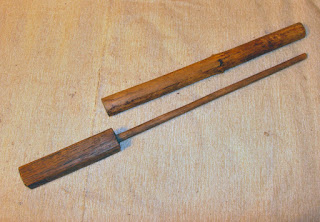 Footwear worn by men and women of the Roman Empire included sandals, which were basically thick leather soles held onto the foot with four or six flexible leather straps forming the 'uppers'. There was a more durable type of shoe favored for the Roman Legion. It was called the calceus, which name was derived from Calx, meaning 'heel'. The calceus, variously calcei or caligae, consisted of a thick leather sole to which was attached a leather upper that covered the entire top of the foot and extended around the heel (hence the name), resembling modern shoes in basic structure. It was eventually discovered that shaping the sole from a thin slab of wood lasted even longer than the thick leather. Flexible leather continued to be used for the upper. Calcei were worn primarily outside, while sandals were favored for inside use.
Footwear worn by men and women of the Roman Empire included sandals, which were basically thick leather soles held onto the foot with four or six flexible leather straps forming the 'uppers'. There was a more durable type of shoe favored for the Roman Legion. It was called the calceus, which name was derived from Calx, meaning 'heel'. The calceus, variously calcei or caligae, consisted of a thick leather sole to which was attached a leather upper that covered the entire top of the foot and extended around the heel (hence the name), resembling modern shoes in basic structure. It was eventually discovered that shaping the sole from a thin slab of wood lasted even longer than the thick leather. Flexible leather continued to be used for the upper. Calcei were worn primarily outside, while sandals were favored for inside use.At some point, shoemakers began to make the sole out of wood to make the shoe even more durable and able to withstand the prolonged use demanded by the Legion's long campaigns.
 In the northern Germanic regions, the Roman calceus was adopted for use, but shoemakers there, as early as the 13th Century, took the design a step further by ridding the shoe of all the leather. The entire shoe, sole and upper, began to be carved out of a single block of wood. With no leather to wear or rot away, the wooden shoe was ideal for use on any terrain, whether dry or wet, sloshy and muddy. In the Germanic regions, the totally wooden shoe was differentiated from its wood and leather ancestor by the name of 'clog'. The word clog was derived from the word clogge, a 14th Century word meaning 'lump of wood'. Clogs became very popular in the Netherlands, Denmark, Germany and France. Their use also spread to the Lower European and Balkan regions, where they were known variously as klumpe or klomp. Shoes with wooden soles developed and came into widespread use in Asia, but they tended to resemble the calcei, moreso than clogs.
In the northern Germanic regions, the Roman calceus was adopted for use, but shoemakers there, as early as the 13th Century, took the design a step further by ridding the shoe of all the leather. The entire shoe, sole and upper, began to be carved out of a single block of wood. With no leather to wear or rot away, the wooden shoe was ideal for use on any terrain, whether dry or wet, sloshy and muddy. In the Germanic regions, the totally wooden shoe was differentiated from its wood and leather ancestor by the name of 'clog'. The word clog was derived from the word clogge, a 14th Century word meaning 'lump of wood'. Clogs became very popular in the Netherlands, Denmark, Germany and France. Their use also spread to the Lower European and Balkan regions, where they were known variously as klumpe or klomp. Shoes with wooden soles developed and came into widespread use in Asia, but they tended to resemble the calcei, moreso than clogs.Wooden shoes went out of favor by the time of the Second World War, although they have remained in use to the present day by European farmers and other occupations which require working in muddy environments.
 Today wooden shoes are generally called "Dutch Shoes" by many Americans, and modern generations are often amazed to find that they were used widely throughout countries such as France. Contributing to the general misconception that wooden clogs are "Dutch" shoes is the fact that most of these shoes that are found in the United States are stamped (or painted) with the phrase: Made in Holland. What most people do not know is that the phrase often refers to Holland, Michigan, where wooden shoes continue to be produced by companies such as the DeKlomp Wooden Shoe & Delft Factory.
Today wooden shoes are generally called "Dutch Shoes" by many Americans, and modern generations are often amazed to find that they were used widely throughout countries such as France. Contributing to the general misconception that wooden clogs are "Dutch" shoes is the fact that most of these shoes that are found in the United States are stamped (or painted) with the phrase: Made in Holland. What most people do not know is that the phrase often refers to Holland, Michigan, where wooden shoes continue to be produced by companies such as the DeKlomp Wooden Shoe & Delft Factory.As can be seen in the examples shown here, designs include such traditional 'Dutch' scenes as windmills and sailing ships. Some shoes, such as three of the above examples, were painted to resemble 'real' shoes with buckles and flaps on the uppers. The one example shows a geometric design carved into the wood. The fourth photo from the top shows 'buttons' attached to the wood and the words 'Souvenir' and 'Belgium' painted on the shoes. One pair is painted with a man's and woman's portraits and the words 'France 1944'. These are only a few examples of what are available as both antique and current designs.















